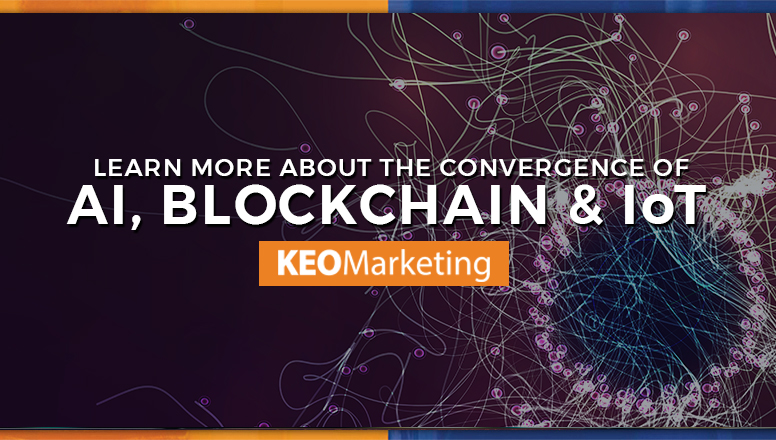The Convergence of AI, Blockchain, and IoT
This is a guest blog article by Sheila Kloefkorn, founder of KEO Marketing.
Three key technologies have emerged in the past decade that experts say have the potential to change the way we do business: artificial intelligence (AI), blockchain, and the Internet of Things (IoT). 2018 is set to be the year that these emerging technologies will converge in a major way, creating the most powerful and secure digital ecosystem of connected, smart technologies.
Background
To get a sense of how these three technologies might integrate with one another, let’s look at some of the basics.
- Artificial intelligence (AI). Today’s AI is a far cry from the dystopian narratives that dominate Sci-Fi movie portrayals of a future where machines take over the world. Rather than putting an end to the world as we know it, AI is more likely to help us create a better life. AI comprises strong algorithms that learn by synthesizing an immense amount of data. AI helps us to make better decisions based on this data and can adjust instantly. Consider how Apple’s Siri digital assistant learns about you from your behaviors and the way you interact with your phone. Siri uses data from tracking your calendar and your decision-making to find patterns that inform its decisions on options and recommendations. For both B2B and B2C companies, AI can speed operations and make interactions easier for your end users.
- Blockchain. Blockchain technology has been in the public consciousness for the better part of a decade thanks to cryptocurrencies like bitcoin. However, by using a decentralized database platform, blockchain networks have advantages that make the dream of ultimate security possible. By decentralizing data within the blockchain, users can eliminate the traditional need for a single authority over data and, instead, verify the validity of a transaction or action in the blockchain in real time. Data in the blockchain exists permanently on the network, attached to adjacent records. This permanent record makes blockchains immutable, linear, and virtually impossible to hack.
- Internet of Things (IoT). Wi-Fi, Bluetooth connectivity, and data networks have connected everyday devices in our homes and businesses to the internet and to one another. IoT encourages us to consider how the “things” in our homes connect to our lives now: refrigerators, light bulbs, your television, even the thermostat all can come with smart connectivity that optimizes their operation to fit within your lifestyle. You can control these smart devices using a smartphone, and new IoT devices crop up every day. In 2018, there are more than 11 billion connected devices. That number is expected to double to more than 20 billion in 2020. IoT, as you can see, is becoming more mainstream and becoming a significant part of daily life.
Working together
As these technologies become a driving force in 2018, their convergence marks an important turning point in this growing digital ecosystem, beginning with blockchain. In the not-too-distant future, we could see a new connected, smart ecosystem that is safe from hacking and interference, rearranging the way the internet works today.
Security is a major issue limiting the widespread use of IoT and AI. Hackers can penetrate today’s online encryption systems, leaving users with too great of a risk. Consider how this scenario impacts industries such as healthcare, where IoT and AI can support life-saving health devices that learn from a patient’s vital statistics. Such devices might need to make life or death decisions about a person’s health, and the hacking of those devices can have devastating consequences.
Blockchain technologies solve that security issue. First, they let users conduct commerce directly by providing a decentralized way to make payments and communicate. Users can create blockchain networks of indexed records that are both linear and permanent. These networks allow others to mention the records globally without censorship. Finally, blockchains let users act as their own certificate authority, meaning that people own their own data. When individuals can act as their own certificate authority, they’ll have control over their data.
Blockchain technology ensures permanence and transparency, making hacking impossible. Because it stores and protects data records, blockchain will help bind a new digital ecosystem together. The security issue is the biggest threat right now facing AI and IoT, and the threat of hackers taking control of devices and records is a big risk that stunts the proliferation of new technologies. When you extend IoT to more devices, you increase the vulnerability of an entry point for hackers into your world. And when AI begins making decisions for IoT devices, you have inherent risks.
Blockchain networks are a scalable, secure, and permanent platform on which AI and IoT can build. The convergence of these three technologies means smarter connectivity capable of changing the way we do business and our daily lives. Big changes are coming in 2018; make sure you get onboard before your competition does.
 Questions? Contact me for help with your business strategy: [email protected].
Questions? Contact me for help with your business strategy: [email protected].

